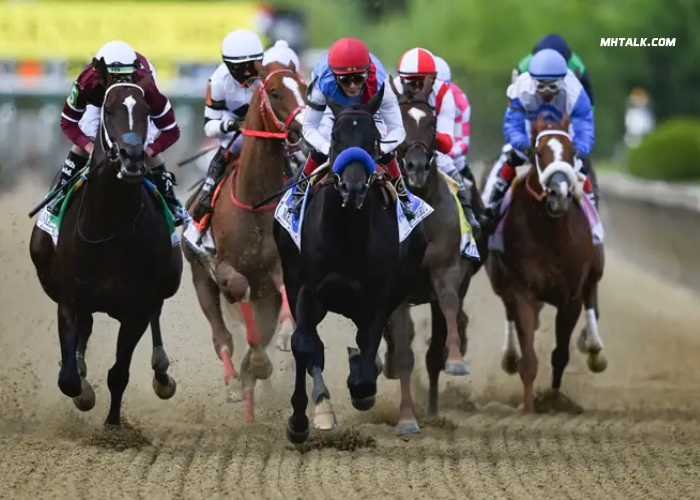Turf racing, also known as horse racing on grass, is a long-standing tradition and popular sport in many countries worldwide. With its unique challenges and strategies, turf racing offers an exciting and thrilling experience for both spectators and bettors. This article will explore the world of turf racing, discuss its advantages, delve into turf racing statistics, examine turf strategy, and provide tips for successful turfing. Additionally, we will highlight some of the best turf racing sites, explore turf marketing courses and services, and conclude with a reflection on the overall appeal of turf racing.
What is turf?
Turf racing refers to horse racing that takes place on grass tracks, as opposed to dirt or synthetic surfaces. The term “turf” is derived from the Old English word “turfet,” which means a clump of grass. Turf racing is renowned for its aesthetic appeal, as horses gracefully glide over the lush green surface, creating a visually pleasing spectacle. The grass track provides a unique challenge for horses, jockeys, and bettors, as the conditions can vary depending on weather conditions and maintenance.
Turf racing is highly regarded for its rich history and cultural significance in many countries. In Europe, turf racing has strong roots, with prestigious events like the Prix de l’Arc de Triomphe in France and the Epsom Derby in the United Kingdom attracting participants and enthusiasts worldwide.
The Kentucky Derby and the Breeders’ Cup Turf have become synonymous with turf racing excellence in the United States. Regardless of the location, turf racing offers an unparalleled experience that combines athleticism, strategy, and the beauty of nature.
The advantages of turf racing
Turf racing presents several advantages that set it apart from other forms of horse racing. One of the primary advantages is the reduced risk of injuries for horses. Grass tracks provide a more forgiving surface than dirt or synthetic tracks, which can be harder on a horse’s legs and joints. The cushioning effect of the grass can absorb some of the impact, reducing the likelihood of injuries. This is a crucial factor for horse owners and trainers, as they prioritize the well-being and longevity of their equine athletes.
Another advantage of turf racing is the diversity it brings to the racing calendar. By offering both turf and dirt races, racing authorities can provide a wider range of race types and distances, catering to different horse abilities and preferences. This diversity adds excitement and variety to the sport, ensuring that racing enthusiasts always have something to look forward to. Additionally, turf racing can attract a different set of horses and jockeys, further enriching the competition and creating new rivalries.
Furthermore, turf racing often requires different skills and strategies than racing on other surfaces. The grass track presents unique challenges, such as changes in ground conditions, turf management practices, and weather factors.
This dynamic environment calls for adaptable horses, skilled jockeys, and astute bettors who can analyze the conditions and make informed decisions. The strategic element of turf racing adds an extra layer of excitement and engagement for those involved, making it a favorite among racing enthusiasts.
Turf racing statistics
Turf racing is a sport that thrives on data and statistics. Analyzing past performance records, turf conditions, and jockey-trainer combinations can provide valuable insights into potential outcomes. By studying turf racing statistics, bettors can make more informed decisions and increase their chances of success. Several key statistics are commonly considered when evaluating turf races.
One crucial statistic to consider is the horse’s performance on turf compared to other surfaces. Some horses excel on grass tracks, while others may struggle to adapt. By examining a horse’s turf record, including previous wins, finishes, and speed figures, bettors can gauge its suitability for the upcoming race.
Another important statistic is the jockey’s performance on turf. Just as some horses prefer grass tracks, certain jockeys have a knack for navigating the intricacies of turf racing. Analyzing a jockey’s win percentage, average finishing position, and past success on grass can provide valuable insights into their expertise and suitability for the race.
Additionally, studying turf racing statistics related to the trainer can offer valuable information. Some trainers specialize in preparing horses for turf races, and their expertise can significantly impact a horse’s performance. Examining a trainer’s win percentage on grass, training style, and track record in specific turf races can help bettors make more informed decisions.
Turf strategy
Developing a sound turf strategy is crucial for success in turf racing. The unique characteristics of grass tracks require a different approach than other surfaces. The following are some key elements to consider when formulating a turf strategy:
- Ground conditions: Turf tracks can vary in firmness, with some being firm and fast while others are softer and more yielding. Understanding how a horse performs on different ground conditions is essential. Some horses excel on firmer turf, while others prefer softer ground. Analyzing the weather forecast and tracking conditions can help bettors identify horses likely to perform well under specific conditions.
- Race distance: Turf racing offers a wide range of race distances, from sprints to longer endurance tests. Different horses have varying preferences for distance, and identifying a horse’s optimal race distance is crucial. Studying past performances and analyzing a horse’s success at different distances can provide valuable insights into their suitability for the upcoming race.
- Jockey-trainer combination: The partnership between a jockey and a trainer can significantly influence a horse’s performance. Some jockeys have a natural affinity for turf racing and excel in navigating the undulating grass tracks. Similarly, certain trainers have a proven track record in preparing horses for turf races. Evaluating successful jockey-trainer combinations can help bettors identify strong contenders.
- Pace analysis: Understanding the pace of a race is essential in turf racing. Some horses perform better when the race has a fast, early pace, while others may excel in races with a slower tempo. Analyzing past races and identifying horses likely to benefit from a particular pace scenario can provide a strategic advantage.
By considering these elements and conducting thorough research, bettors can develop a comprehensive turf strategy that maximizes their chances of success.
Creating your turf plan
Creating a turf plan is an essential step for bettors aiming to achieve consistent success in turf racing. A turf plan outlines the approach, research methods, and betting strategies that will be employed. The following steps can guide the creation of an effective turf plan:
- Define objectives: Start by defining your goals and objectives. Are you looking to make a profit, enhance your knowledge of turf racing, or simply enjoy the excitement of betting? Clearly defining your objectives will help shape your turf plan.
- Research: Conduct thorough research on turf racing, including analyzing past performances, studying turf statistics, and keeping abreast of the latest news and developments. Utilize reputable sources, such as turf racing websites, racing publications, and expert opinions.
- Identify key factors: Identify the factors you believe have the most significant impact on turf race outcomes. These factors include horse form, jockey-trainer combinations, turf conditions, and race distance. Prioritize the factors that you believe are most influential and focus your research efforts accordingly.
- Develop a betting strategy: Based on your research and analysis, develop a strategy that aligns with your objectives and risk tolerance. This strategy can include selecting specific types of bets, setting betting limits, and identifying value opportunities.
- Track and analyze results: Keep a detailed record of your bets, including the horses selected, the bet types, and the outcomes. Regularly review and analyze your results to identify areas of improvement and refine your turf plan.
Remember that creating a turf plan is an ongoing process that requires continuous learning and adaptation. As you gain more experience and refine your strategies, your turf plan will evolve to reflect your growing expertise.
Tips for successful turfing
Turf racing can be both rewarding and challenging. To increase your chances of success, consider the following tips:
- Stay informed: Keep up-to-date with the latest news, turf racing statistics, and developments in the racing industry. Knowledge is a powerful tool in turf racing, and staying informed will help you make more informed decisions.
- Follow expert advice: Listen to expert opinions and analysis from reputable sources. Experts often have valuable insights and can provide a different perspective that may enhance your understanding of turf racing.
- Practice bankroll management: Set a budget for your turf betting activities and adhere to it. Avoid chasing losses or increasing your bets in an attempt to recoup losses. Proper bankroll management will help you maintain discipline and protect your betting capital.
- Utilize multiple betting strategies: Consider diversifying your betting strategies to increase your chances of success. Experiment with different types of bets, such as win, place, or exotic bets, and evaluate which strategies work best for you.
- Learn from your mistakes: Analyze your past bets and outcomes to identify areas for improvement. Learning from your mistakes and adjusting your approach accordingly is essential for long-term success in turf racing.
Remember, turf racing is a sport that requires patience, discipline, and continuous learning. By implementing these tips and refining your strategies over time, you can enhance your turfing experience and increase your chances of success.
The best turf sites – PMU, ZEturf, Genybet
When it comes to turf racing, having access to reliable and user-friendly turf racing sites is crucial. Here are three of the best turf sites that offer a comprehensive platform for all your turf racing needs:
- PMU: PMU is a leading turf racing site in France, offering a wide range of turf races and betting options. With a user-friendly interface and extensive coverage of French turf racing, PMU provides a seamless experience for both beginners and experienced bettors. Additionally, PMU offers live streaming of races, race replays, and expert analysis to enhance your turf racing experience.
- ZEturf: ZEturf is a popular turf racing site that caters to a global audience. With a wide selection of worldwide turf races, ZEturf provides an extensive betting platform for enthusiasts. The site offers a range of betting options, including win, place, and exotic bets, as well as live streaming of races and detailed race information to assist bettors in making informed decisions.
- Genybet: Genybet is a comprehensive turf racing site that combines betting, news, and analysis in one platform. With a user-friendly interface and an extensive database of turf racing information, Genybet offers everything you need to enhance your turf racing experience. The site provides live streaming of races, race replays, expert tips, and betting options to cater to all bettors.
These turf racing sites provide a reliable and convenient platform for all your turf racing needs, ensuring you can enjoy the excitement of turfing from the comfort of your home.
Turf marketing course
For those interested in the business side of turf racing, a turf marketing course can provide valuable insights and knowledge. A turf marketing course covers various aspects of marketing in the turf racing industry, including branding, customer acquisition, and event promotion. By enrolling in a turf marketing course, individuals can gain a deeper understanding of the industry and acquire the skills necessary to succeed in turf marketing roles.
Reputable educational institutions typically offer turf marketing courses which can be completed online or in person. These courses often include lectures, case studies, and practical assignments to ensure a well-rounded learning experience.
Whether you are a racing enthusiast looking to explore a career in the industry or a current professional seeking to enhance your marketing skills, a turf marketing course can provide valuable knowledge and networking opportunities.
Turf marketing services
In addition to turf marketing courses, various turf marketing services are available for businesses and individuals in the racing industry. These services assist with marketing strategies, brand development, and customer engagement. Turf marketing services can provide expert advice and support in social media marketing, content creation, and event promotion.
By leveraging turf marketing services, businesses can enhance their visibility, attract new customers, and create a strong brand presence in the racing industry. These services often utilize industry-specific knowledge and expertise to tailor marketing strategies to the unique challenges and opportunities of turf racing.
Conclusion
Turf racing offers a unique and exciting experience for both spectators and bettors. With its aesthetic appeal, strategic challenges, and rich cultural history, turf racing continues to captivate audiences worldwide.
By understanding the advantages of turf racing, analyzing turf racing statistics, developing a sound turf strategy, and utilizing reputable turf racing sites, enthusiasts can enhance their turfing experience and increase their chances of success.
For those interested in the business side of turf racing, turf marketing courses, and services provide valuable knowledge and support to navigate the industry. Whether you are a seasoned turf racing enthusiast or a newcomer to the sport, the allure and thrill of the ROI du Turf are not denied.
Related posts
Recent Posts
InformalNewz: A New Era of Unconventional News Reporting
In the ever-evolving landscape of media and journalism, new platforms and approaches are constantly emerging to meet the demands of…
Balanced Living: Strategies for Achieving Wellness in a Hectic World
In today’s fast-paced world, achieving a sense of balance can often feel like an elusive goal. Juggling work, family, social…



